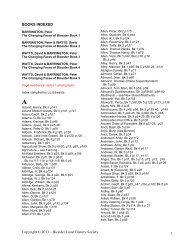Draft Bicester Conservation Area Appraisal November 2009
Draft Bicester Conservation Area Appraisal November 2009
Draft Bicester Conservation Area Appraisal November 2009
You also want an ePaper? Increase the reach of your titles
YUMPU automatically turns print PDFs into web optimized ePapers that Google loves.
8.4 Building Construction, Materialsand ElevationsThe white limestone and blueish greylimestone of the Cornbrash have beenquarried locally at Caversfield andCrockwell and are a characteristic of theolder buildings. The heavy Oxford clayshave also been used for brick making;clay pits east of London Road wereworked until the end of the 19th century.The predominant building material islimestone rubble brought to courses.Years of lime washing has been followedby many buildings being rendered andpainted, sometimes scored to give theappearance of ashlar. From Church Streetto Market Square there are now fewbuildings not rendered. Course squaredlimestone is in evidence in some of themore imposing buildings e.g. The Churchof St Edburg, <strong>Bicester</strong> House, the OldVicarage and on some propertiesconstructed around the mid 19th centurysuch as the former Magistrates CourtHouse and no’s 2 and 4 Church Street.Ashlar is generally restricted to quoinsand window surrounds with the exceptionof the early/mid 19th century building nowoccupied by Barclays Bank which is nowpainted.Some of the earliest buildings are timberframed but are now mainly rendered over.In the early 19th century some buildingswere re-faced in brick, as was the fashion.Commercial premises within thesebuildings tend to have a greater numberof divisions in their shop fronts asstructural support. This is in contrast tothe more modern commercial buildings,particularly those on Sheep Street whichcan have larger expanses of plain glazingdue to the structural support given by theirconcrete construction.By the end of the century most buildingswere entirely constructed in brick as thecheaper and easily obtainable alternativeto stone e.g. at North Street. Thepredominant brick colour is red but yellowand blue engineering bricks are alsofound, often used decoratively as stringcourses and window surrounds e.g. PrioryRoad.Very frequently the bricks are laid inFlemish bond with either the vitrifiedheader or blue header laid alternativelywith red stretchers to create a chequerbond effect e.g. North Street. Early 20thcentury residential terraces have beenconstructed from yellow/buff brick,sometimes with terracotta detailing.Terracotta detailing on Priory RoadSome brick residential properties havebeen altered to insert commercialpremises into the ground floor. This cancreate an unsympathetic front elevation.In contrast, on The Causeway, buildingswhich have been originally constructed asshops maintain the same proportions andmaterials as the adjoining residentialproperties.North Street, the ground floor take away hasreplaced the original bay window, unbalancingthe front elevation.27



